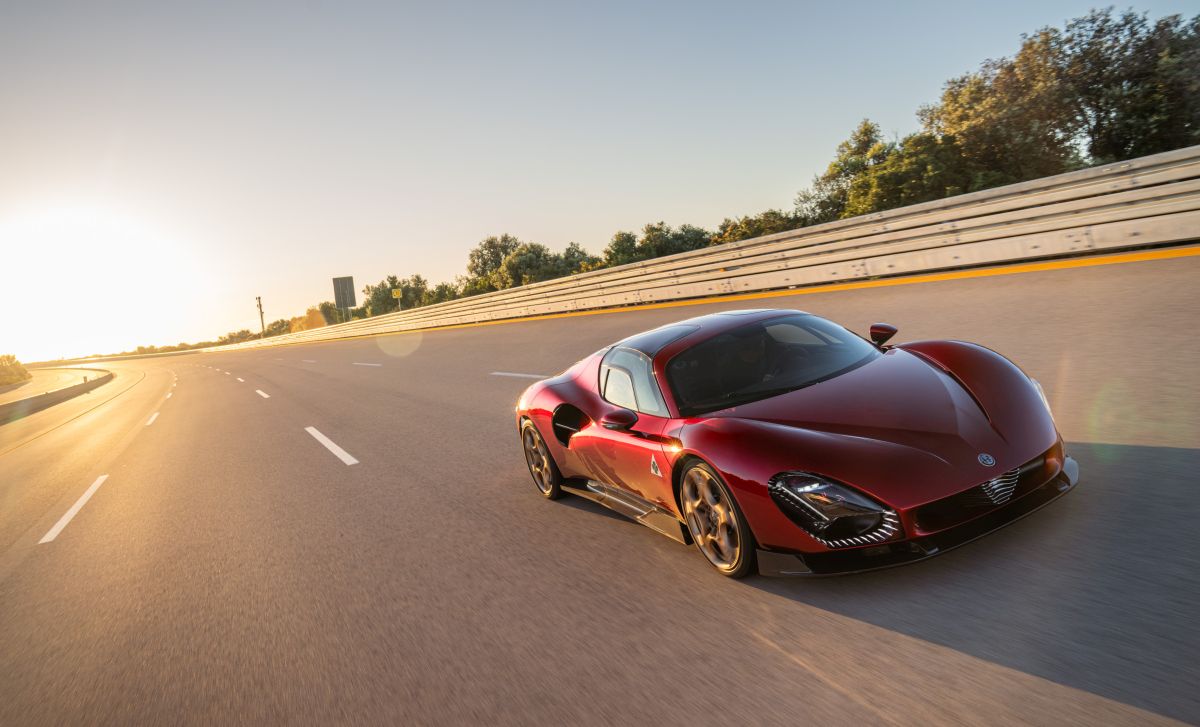TURIN (ITALPRESS) – Alfa Romeo’s team of engineers recently finished an intensive testing session on the “prototype 00” of the new 33 Stradale at the Nardò circuit to test its driving dynamics and performance under extreme conditions at very high speed. Specifically, the test team monitored and validated dynamic parameters such as aerodynamics, top speed, maximum temperatures, propulsive cooling systems and cabin soundproofing. All in preparation for the first scheduled delivery in Italy in late December. Because of the type of high-speed tests that were to be conducted, Alfa Romeo’s choice could only fall on the Nardò Technical Center (NTC), one of the world’s most advanced testing and experimentation centers, located in Salento, Italy, where the most emblazoned automotive brands conduct their tests. Built in 1975 by FIAT, today the Apulian proving ground covers an area of 700 hectares, embellished with forests and Mediterranean scrubland, and boasts as many as 20 test tracks for testing and development activities at any level.Prominent among these tracks is the famous Nardò Ring for high-speed testing of cars and motorcycles, which has a diameter of four kilometers and a length of 12.6 kilometers. Considered the fastest circular car track in the world, the circuit offers different inclines and relative compensatory speeds for each of its four lanes. Due to its low parabolic profile, driving on each lane at the compensatory speed that balances the centrifugal force, drivers have the feeling of driving on an endless straight. It was on this very loop track that the Alfa Romeo team ran high-speed tests on the development road 33, validating the top speed target of 333 km/h as well as the acceleration that goes from 0 to 100 km/h in less than 3 seconds. This is thanks to the meticulous work done by Alfa Romeo engineers on aerodynamics, in which every line of the car’s sculptural volume is functional in achieving the best aerodynamic performance, thus enhancing the performance of the 3.0-liter twin-turbocharged V6 engine with more than 620 hp, 8-speed DCT gearbox, rear-wheel drive and electronic limited slip differential. An evolution of the V6 that already powers the Italian brand’s highest-performance cars, the new powerplant is mid-mounted longitudinally and delivers outstanding performance, all of which was fully confirmed in Nardò.The dynamic tests carried out at the Nardò Technical Center follow a session held a few weeks ago at the Proving Ground in Balocco (VC), on the iconic Alfa Romeo track that since 1962 has hosted the development and preparation of the highest performance and racing cars (Autodelta) used in international F1, DTM and Super Turismo competitions. In this historic location, the same team of Alfa Romeo engineers had focused the entire session on specific moderate- and high-speed tests, with a targeted focus on balance, braking system and road handling. Then again, the dynamic goal of the project has always been extremely ambitious: to offer the best driving experience in its class. In particular, at Balocco the first test was conducted at moderate speed, to evaluate the precision of the steering system and the response of the braking system, as well as the characteristic handling guaranteed by the system consisting of an aluminum H-frame, carbon fiber monocoque and refined suspension configuration. Moreover, as everything is designed and aimed at maximum man-machine involvement, the car offers two driving modes, which can be activated by switches on the central tunnel: Strada and Pista. The first, which is present when the car is started, ensures comfort and driving pleasure: smooth power delivery, usual pedal sensitivity, soft suspension, smooth shifting and active exhaust valves open only above 4,000 rpm. In Track mode, on the other hand, the driver chooses an adrenaline-fueled ride: power is maximized, the pedals are even more responsive and the suspension stiff, as well as offering quick shifts and active exhaust valves that are always open. Among the most exhilarating performance controls in this configuration is the “Quick Start” procedure, which, by pressing the “Quadrifoglio” button on the center tunnel, acts on the gearbox, traction control and power to maximize acceleration while avoiding wheel spin.In some sections of the Balocco circuit, moreover, Alfa Romeo test drivers switched off traction control (ESC OFF) bringing the car close to its top speed, confirming that the 33 Stradale manages to combine supercar performance with surprising ease of driving, even for those who are not professional drivers. All of this is made even more impressive by the sound of the twin-turbo V6, an authentic “mechanical symphony” that envelops the cabin and gives unique emotions with every acceleration. The active suspension system also played a key role in the test, offering a perfect combination of comfort and performance. Specifically, the new fuoriserie adopts Alfa Romeo’s 100% double-arm suspension scheme with active dampers and semi-virtual steering on both axles, front and rear, which allows the best steering wheel control and the highest degree of steering precision, as well as ensuring high lateral acceleration guaranteeing the best handling in any driving condition.Finally, the session in Balocco highlighted the precision and ability of the brakes to adapt to different driving modes, always ensuring excellent control, so much so that the new 33 Stradale brakes from 100km/h to 0 in less than 33 meters. This is thanks to the integrated Alfa Romeo Brake-By-Wire braking system, which allows both control of braking pressure and adaptation of the always stable pedal feel. Produced by Brembo for Alfa Romeo, the carbon-ceramic brakes provide high performance and ensure responsive braking with reduced fade effect at high temperatures. At the front and rear, the discs are ventilated and drilled type with, at the front, a 6-piston aluminum monoblock caliper and at the rear, a 4-piston caliper.
photo: stellantis press office
(ITALPRESS).

